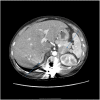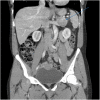Ectopic Cushing's syndrome from an ACTH-producing pheochromocytoma with a non-functioning pituitary adenoma
- PMID: 35319487
- PMCID: PMC9002181
- DOI: 10.1530/EDM-21-0189
Ectopic Cushing's syndrome from an ACTH-producing pheochromocytoma with a non-functioning pituitary adenoma
Abstract
Summary: An adrenocorticotropic hormone (ACTH)-producing pheochromocytoma (PCC)/paraganglioma is the cause of ectopic Cushing's syndrome (CS) in 5.2% of cases reported in the literature. We present a previously healthy 43-year-old woman admitted to our hospital with cushingoid features and hypertensive urgency (blood pressure = 200/120 mmHg). Her 24-h urinary free cortisol was >4270 nmol/day (reference range (RR) = 100-380 nmol/day) with a plasma ACTH of 91.5 pmol/L (RR: 2.0-11.5 pmol/L). Twenty-four-hour urinary metanephrines were increased by 30-fold. Whole-body CT demonstrated a 3.7-cm left adrenal mass with a normal-appearing right adrenal gland. Sellar MRI showed a 5-mm sellar lesion. MIBG scan revealed intense uptake only in the left adrenal mass. She was managed pre-operatively with ketoconazole and phenoxybenzamine and underwent an uneventful left laparoscopic adrenalectomy, which resulted in biochemical resolution of her hypercortisolemia and catecholamine excess. Histology demonstrated a PCC (Grading System for Adrenal Pheochromocytoma and Paraganglioma score 5) with positive ACTH staining by immunohistochemistry. A PCC gene panel showed no mutations and there has been no evidence of recurrence at 24 months. This case highlights the difficult nature of localizing the source of CS in the setting of a co-existing PCC and sellar mass.
Learning points: An adrenocorticotropic hormone (ACTH)-producing pheochromocytoma (PCC) is an important item to be considered in all patients presenting with ectopic Cushing's syndrome (CS). In exceptionally rare cases, patients with ectopic CS may present with multiple lesions, and a systematic approach considering all potential sources is crucial to avoid misdiagnosis. CS with a large adrenal mass but lacking contralateral adrenal atrophy should raise suspicion of an ACTH-dependent process. In patients with clinical suspicion of PCC, clinicians should be mindful of the use of steroids and beta-blockers without appropriate alpha blockade as they may precipitate an adrenergic crisis.
Figures






References
LinkOut - more resources
Full Text Sources

